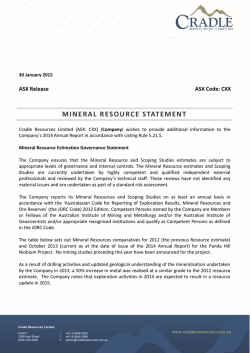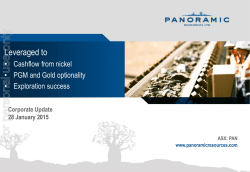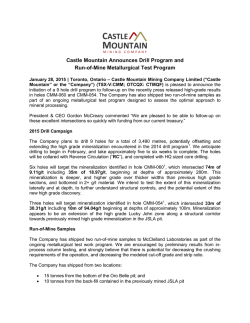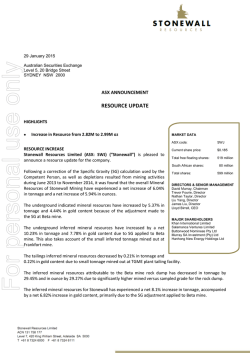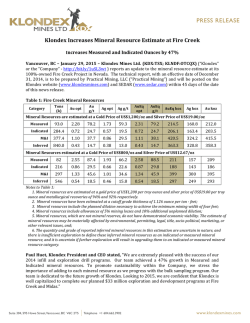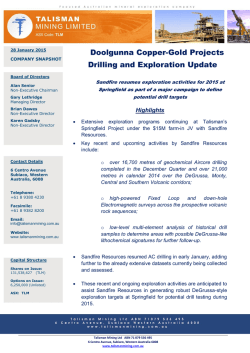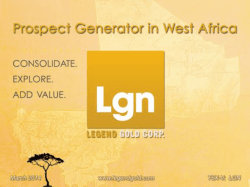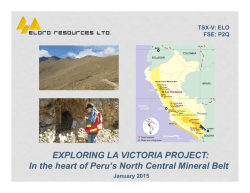
For personal use only - Australian Securities Exchange
ASX ANNOUNCEMENT For personal use only 30 January 2015 QUARTERLY REPORT FOR THE PERIOD ENDED 31 DECEMBER 2014 Company Facts Strandline Resources (ASX: STA) ‐ Exposure to major ‘construction ready’ Coburn Heavy Mineral Sands Project in Western Australia and emerging country‐wide exploration play in Tanzania, within a major mineral sands producing corridor Highlights Heavy Mineral Sands Exploration, Tanzania o Auger drilling completed at high priority prospects with strong visual indications from pan samples ‐ results pending Key projects: Coburn Heavy Mineral Sands Project, WA (100%) Tanzanian Heavy Mineral Sands Exploration Projects (100%) Mt Gunson Copper Exploration Project, SA (100%) Mt Gunson MG14/Windabout Copper‐ Cobalt‐Silver Development Project, SA (100%) Fowlers Bay Nickel Project, SA (100%) – Western Areas Earning In o Acquisition of key Ziwani tenement consolidates +12km prospective strike at southern projects Coburn Heavy Mineral Sands (WA) – Review underway Mount Gunson Copper Production Project (SA) – Feasibility studies continue to significantly de‐risk project with game‐ changing improvements in metal recoveries indicating: Copper recoveries of up to 90% are achievable High value cobalt recoveries of + 80% are achievable Corporate Structure Fowlers Bay Gold‐Base Metal Project (SA) – Extremely encouraging magnetic survey kicks of JV with Western Areas with major drilling campaign to test key targets in mid 2015 Shares on issue Unlisted Options 615.5m 15.6m Company Directors Corporate Michael Folwell Non‐Executive Chairman o Richard Hill Managing Director Bill Bloking Non‐Executive Director Didier Murcia Non‐Executive Director Completion of Strandline acquisition, capital raising and name change Investor Enquiries Warrick Hazeldine Cannings Purple E: [email protected] T: +61 (0) 417 944 616 www.strandline.com.au Page 1 ASX ANNOUNCEMENT 30 January 2015 For personal use only TANZANIAN HEAVY MINERAL SANDS PROJECTS (100%) During the Quarter, Strandline Resources Limited (ASX: STA) (“Strandline” or the “Company”) geologists carried out a systematic mapping and sampling programme across the Company’s 2,000km2 Tanzanian mineral sands portfolio and completed a successful auger drill programme on high priority targets at its southern Projects. This regional programme was completed using the Company’s exclusive country wide geochemical HMS database across high priority targets on its Northern (Kitambula), Central Coast (Mafia Island) and Southern (Madimba) Project areas (see Figure 1). The program was successful in identifying new areas of heavy mineral sands (HMS), confirming and extending known areas of HMS occurrences and determining access for future exploration activities. It was also apparent from the field trip that access to established port facilities at Tanga in the north and Mtwara in the south will greatly enhance project economics should the company be successful in a HMS discovery. Based on strong evidence from the regional exploration programme and geochem database the Company completed its first shallow auger program at the Southern Projects, including the Madimba project and recently acquired Ziwani project. The auger program comprised 140 auger holes drilled to approximately 6m depth that covered the Madimba West, East and Ziwani historic soils anomalies. While assay results are pending for this program visual estimates of heavy mineral from the pan samples have confirmed the prospectivity of these anomalies. www.strandline.com.au Figure 1. Tanzanian coastline showing key projects and infrastructure. Page 2 ASX ANNOUNCEMENT 30 January 2015 For personal use only Field activities details for each of the projects worked on this quarter follow: Central Coastal Project ‐ Mafia Island Evidence of modern accumulations of high grade HMS mineralisation was identified at a number of coastal locations within the Mafia Island tenement (see Figure 2). Figure 2. Map of Mafia Island showing the location of tenement (PL8197/2012) covering the western portion of the Island Insert: Figure A. Mafia Island heavy mineral accumulation (black sand) on the modern beach environment; Figure B. Mafia Island modern beach heavy mineral accumulation with very high grade mineral sands encountered at the bottom of the hole (black sand). Figure A (inset to Figure 2) is a photograph taken from a location on the western side of the island. The figure shows very high grade heavy mineral mineralisation at surface and at the bottom of the hole. Mineralisation was identified along a 2km stretch of beach at three locations. www.strandline.com.au Page 3 ASX ANNOUNCEMENT 30 January 2015 For personal use only Figure B (inset to Figure 2) shows an example of a modern HMS accumulation at the high water mark on the southern coast of the island. The heavy mineral extends for 700m along the shoreline. This represents a compelling priority target and exploration to be carried out in the short term will involve auger drilling the coastal plain environments targeting older paleo‐shorelines with potentially high grade strandline related mineralisation. The Company has taken HMS samples for mineral assemblage characterisation from the modern beach accumulations and is awaiting final analysis of the results. Northern Projects ‐ Kitambula Project The Kitambula Project is located just 50km south of the operating Kwale Mine (262 Mt @ 3.7% HM) and is close to the port town of Tanga. In preparation for targeting of auger drilling, the key areas of the 35km2 contiguous tenement package, including the recently granted southern tenement, PL 9976/2014, were visited. The site of recent shallow auger drilling which included hole AR042 which intersected 2.9m @ 3.38% Total Heavy Mineral (THM) from surface until the end of hole was examined (see Figure ). The surface site examination revealed enrichment of HMS in the drainages and sands eroding from the site with a pan sample of the soil estimated to contain 3 to 4% THM mineralisation which confirms the laboratory assay of 3.38% THM encountered in the drill hole. The surrounding auger holes also contained shallow intervals of 1 to 2% THM with auger drill spacing 200 to 250m along lines and 1,000m between the lines. One drill fence of historic air core (AC) drilling located approximately 1.5km to the south east has results that include: TGAC006: 22m @ 2.43% THM from surface (including 4m @ 5.2 % THM from 6m) TGAC011: 6m @ 6% THM from 35m TGAC012: 3m @ 5.7% THM from 36m TGAC013: 7m @ 4.15% THM from 4m TGAC014: 2m @ 4.8% THM from 21m Significantly drill hole AR042 was also chosen as one of 5 composite samples for mineral assemblage characterisation studies (Refer to the Company’s ASX release dated 11/09/2014). The results have shown an impressive percentage of valuable heavy mineral (VHM) with 74.4% of the THM containing 63.9% ilmenite, 6.2% rutile and 4.1% zircon. Recently granted tenement of PL 9976/2014, which represents the southern‐most tenement in the Kitambula package was evaluated for strandline and dunal styles of HMS mineralisation (see Figure 3). Strong concentrations of HMS were discovered at a number of locations within the tenement. One roadside cutting revealed strong accumulations of heavy mineral in the drainage (see Figure 4). A north trending elevated ridge some 1750m long and 200m wide was identified from detailed topographic maps. This was followed up with some initial pan sampling with two pans completed by Company geologists adjacent to the ridge showing 2 to 4% THM. Significantly there is no previously recorded exploration of this new target. The Company plans to drill test the existing targets in the Kitambula‐Tanga project area with initial focussed auger drilling followed by aircore drilling in areas where resource potential is delineated. www.strandline.com.au Page 4 ASX ANNOUNCEMENT 30 January 2015 For personal use only Additionally, grid based auger drilling will be employed to test the larger tenement position. Auger drilling of the Kitambula Targets is planned to commence in early 2015 following the wet season. Figure 3. Location Map showing a portion of the Company’s Northern Project (Kitambula) showing drill targets based on historical and recent reconnaissance work. Figure 4. Heavy mineral sand (black sand) accumulation from roadside drainage. www.strandline.com.au Page 5 ASX ANNOUNCEMENT 30 January 2015 For personal use only Southern Projects ‐ New Acquisition & Drilling During the Quarter, the Company secured a key tenement immediately to the north of the high priority Madimba tenement. This 100% acquisition of the tenement known as Ziwani adds 76km² to the area and extends the strike potential of Madimba HMS anomalies by an additional 5kms (see Figure 5). Figure 5. The Madimba tenement and newly acquired Ziwani tenement showing prospectivity of the project area and pan sample from hole MTPA068 at Madimba East. Historical surface sampling delineated a number of heavy mineral sands anomalies with peak values of up to 3% THM (see Figure 5). The historic database shows previous regional samples at Mtwara contained up to 4.35% THM with elevated rutile and zircon with a combined total of 8% of the valuable heavy mineral. Average TiO2 ilmenite microprobe analysis based on 19 samples from this region is 55.7% TiO2. www.strandline.com.au Page 6 ASX ANNOUNCEMENT 30 January 2015 For personal use only The consolidated Madimba – Ziwani project area is an exciting target in southern Tanzania close to the port town of Mtwara and became the focus for the Company’s drilling programme during the December quarter. The auger drilling program comprised a total of 140 auger holes drilled on a broad grid pattern at the Madimba, Madimba East and Ziwani HMS prospects to approximately 6m depth for a total of 776m for 415 samples (including field duplicates). This systematic, wide spaced drilling was designed to test beneath the historical HMS surface anomalies generated from the Company’s exclusive geochemical database and recent reconnaissance sampling (see Figure 5). The drilling at Madimba targeted the central portion of the 6km long HMS anomaly and has confirmed a strongly mineralised corridor over a 2km strike and up to 1km width with visual estimates >1.5% THM at both the north western and south eastern ends. Drilling at the Madimba East discovery and initial work has been very successful in identifying new areas of shallow high grade mineralisation with visual panned estimates of the drill spoils ranging 3 to 5% THM. It should be noted that hole depths have been limited to 6m and many holes end in mineralisation (>1.5% visually estimated THM). Therefore, in most cases, the depth potential has not been fully tested, mineralisation remains open awaiting further testing with more sophisticated methods of drilling such as aircore. The Company is currently awaiting the assays and will be undertaking mineral assemblage test work using representative composites from across all project areas. The plan will be to continue with the first phase of auger sampling and then target ranking prior to mobilising a drill rig to test its resource potential. The Company is also considering a ground magnetic survey to help constrain the current anomalies at Ziwani and Madimba. Note 1: All historic data presented in this report has been released in full on 11 September 2014. Note 2: Appendix 1 has Table 1 of the JORC code that explains the pan sampling technique used by the Company to sample and estimate THM percentages from the pan samples. www.strandline.com.au Page 7 ASX ANNOUNCEMENT 30 January 2015 For personal use only COBURN HEAVY MINERAL SANDS DEVELOPMENT PROJECT (100%), Western Australia Project Review and Strategic Partnering During the quarter, the Company commenced a review of the Coburn Project to identify opportunities to reduce costs and add value. The Company is also investigating a range of strategic partners to take an interest in the Project and is actively targeting interested investors. MG14/WINDABOUT Cu‐Co‐Ag DEVELOPMENT PROJECT (100%), Mount Gunson, South Australia As reported on 28 January, 2015, Pre‐Feasibility Studies were ongoing during the quarter into the mining and processing of Strandline’s MG14 and Windabout copper‐cobalt‐silver resources (“the Mining Projects”) in South Australia. The Mining Projects are contained within Strandline’s 100% owned Mt Gunson Copper Project, a large (825km2) tenement package (Table 3) centrally located in the world‐class Olympic Dam copper‐gold province and situated 130km north of Port Augusta, with roads and power to site (see Figures 6 & 7). Mt Gunson is the third‐largest copper producing district in South Australia, with historical production estimated at over 170,000 tonnes. The Windabout and MG14 deposits are shallow, flat‐lying black‐shale hosted copper‐cobalt‐silver sulphide deposits with a combined Indicated Resource estimate totalling 20.3 million tonnes averaging 1.03% copper, 0.05% cobalt and 10.32 g/t silver for 210,000t contained copper (Tables 1 & 2). Figure 6: Mt Gunson Copper Project in South Australia www.strandline.com.au Figure 7: Location of Windabout and MG14 deposits (green) within the Mt Gunson Copper Project Page 8 ASX ANNOUNCEMENT 30 January 2015 For personal use only Successful preliminary test‐work completed in the first half of 2014 was followed up with more detailed test‐ work which was completed in the December Quarter 2014. This program included sodium cyanide leach tests, leach‐tailings flotation and sodium cyanide regeneration tests on 55 available Windabout drill samples. The results demonstrated that, while variable, about 70 to 75% of the copper in the Windabout deposit and 85 to 90% of the copper in the MG14 deposit (previously analysed) was readily leached by cyanide into solution. In addition, a preliminary program of float test‐work on the residues from the leach has shown that a significant proportion of the remaining copper can be floated into a concentrate. This is a critical development for the potential economics of the development of the deposits, as overall copper recoveries of more than 90% may be achievable by the combined leach‐float process. The copper recoveries represent a dramatic improvement from previous test‐work which applied a conventional sulphide flotation test and achieved recoveries of only 54% to 68% which were considered sub‐ economic. These tests also showed more than 80% of the cobalt and 50% of the silver reporting into this concentrate. Significantly, cobalt is currently about twice the value of nickel and five times the value of copper so this will also have a potentially positive impact on project economics. The test‐work also demonstrated that copper is readily precipitated from the pregnant leach solution as potentially saleable chalcocite (copper sulphide Cu2S) and that sodium cyanide regeneration, a key cost driver of the cyanide leach process, could be achieved at a level in excess of 80% by the CSIRO‐developed SART (Sulphidisation, Acidification, Recovery, Thickening) process which is in commercial use at a number of mining operations. Torrens can earn a 51% interest in the Mining Projects by undertaking, at its sole cost (up to $2.5M), all tests and studies necessary to determine the viability of a mining and processing operation at Mt Gunson, and deliver a Bankable Feasibility Study by mid‐2016. Torrens is expecting to complete its Pre‐Feasibility Studies over the coming months with a seamless transition into a Bankable Feasibility Study by mid‐year. Upcoming Scope of Works The upcoming scope of feasibility works at the Project for the first half of 2015 includes: Mineral Resources – Drilling campaign planned to provide more samples to complete metallurgical test‐work and assist with JORC 2012 mineral resource updates and preliminary planning of the mining operations. www.strandline.com.au Page 9 ASX ANNOUNCEMENT 30 January 2015 For personal use only ABN 32 090 603 642 Metallurgy – Ongoing leaching, flotation and hydro‐classification test‐work to refine and optimise the mineral processing flowsheet. Mining Studies – mine design for the Windabout pit by independent mining engineers familiar with the use of Bucketwheel Excavator mining systems. The engineers will produce more accurate data on mine operational and capital costs. The engineers will also undertake 3D modelling of the mineral deposits, including geostatistical analyses to metallurgical metal recovery data with exploration grade analytical data. Approvals and Licenses – commencement of the mining approvals process with the South Australian Department of State Development. About MG14 and Windabout Mineral Resources The MG14 Resource has a footprint of 1000m by 250m below about 25m of cover. Discovered in 1973, the deposit has been tested by a total of 117 drill holes and remains open to the north‐west. A JORC 2012 compliant Mineral Resource was estimated by T. Callaghan in June 2013, with a Cut‐off Grade of 0.5% Cu and an average SG of 2.5. (see ASX announcement 6 June 2013): Tonnes Contained Classification Cu % Co (ppm) Ag (g/t) (millions) Copper (tonnes) Inferred 0.43 0.7 274 10 Indicated 1.62 1.4 397 14 TOTAL 2.05 1.3 3.71 14 26,650 Table 1. MG14 Mineral Resource Summary The Windabout deposit, located about 6km north of MG14 and is approximately 2km by 1km in area. The deposit is also flat‐lying at about 70m below surface. Also discovered about 1973, the deposit has been extensively tested by 195 drill holes. The larger Windabout deposit has a pre‐2000 JORC Indicated Resource estimate1 of 18.7 million tonnes averaging 1% copper, 500 ppm cobalt and 10 g/t silver at 0.5% copper cut off. Tonnes Contained Classification Cu % Co (ppm) Ag (g/t) (millions) Copper (tonnes) Indicated 18.7 1.0 0.05 10 187,000 Table 2. Windabout Mineral Resource Summary 1 The JORC compliant Mineral Resource was estimated by F. J. Hughes in 1997. This Resource estimate has not been updated to comply with the JORC Code 2012 on the basis that the information has not materially changed since it was last reported. www.strandline.com.au Page 10 ASX ANNOUNCEMENT 30 January 2015 ABN 32 090 603 642 For personal use only MOUNT GUNSON COPPER EXPLORATION PROJECT (100%), South Australia Outside the areas containing the Windabout and MG14 Resources (see Figures 6 & 7), Strandline’s 100% owned Mt Gunson exploration ground (Table 3) has previously been the subject of joint venture exploration with several major mining groups. This work generated a number of high priority copper‐gold and copper‐ cobalt‐silver targets requiring further drill testing. Much of the exploration focus in recent years has been on the search for Olympic Dam‐style mineralisation with BHP Billiton’s world class copper‐gold‐uranium mine only 100kms to the north. During this period, Strandline’s 100% owned Emmie Bluff copper‐cobalt‐silver resource was discovered while drilling through the Cover Sequence. With a pre‐2000 JORC Inferred Resource estimate2 of 24Mt averaging 1.3% Cu, 600ppm Co and 10g/t Ag, Emmie Bluff is similar in size, shape and composition to Windabout. However, it is located at approximately 450m depth from surface and could be a source of additional resource if Windabout and MG14 can be brought to production. During the Quarter the Company has set about compiling and interpreting all past exploration data with a view to determining its next steps to test these potentially very large targets that have previously been generated across the tenement. Tenure At Mt Gunson, Strandline holds 3 exploration licences: Tenement Name Area (sq km) Start Date Expiry Date EL4460# Mt Gunson 463 25/03/2010 24/03/2015 EL5333* Yeltacowie 291 07/10/2013 06/10/2015 EL5108 Mt Moseley 71 29/10/2012 28/10/2017 Table 3. Mt Gunson Project Tenements (amalgamated expenditure arrangement agreed with South Australian Government) # EL4460 is currently under application for renewal as ELA2014/00274 *includes the Emmie Bluff resource FOWLERS BAY GOLD‐BASE METAL PROJECT (100%), South Australia – JV with Western Areas As announced on 22 January 2015, Western Areas Limited (ASX: WSA “Western Areas”) completed a detailed magnetic survey over Strandline’s 100% owned, 700km2 Fowlers Bay Project during the quarter (see Figure 8). This survey represents the first stage of Western Areas’ joint venture earn in to Fowlers Bay, a key part of a major exploration push in the Western Gawler region of South Australia. 2 The JORC compliant Mineral Resource was estimated by H. L. Paterson in 1998. This Resource estimate has not been updated to comply with the JORC Code 2012 on the basis that the information has not materially changed since it was last reported. www.strandline.com.au Page 11 ASX ANNOUNCEMENT 30 January 2015 ABN 32 090 603 642 For personal use only Western Areas has indicated that preliminary interpretation of the survey data is extremely encouraging and the high resolution images have highlighted numerous features likely to represent large mafic‐ultramafic intrusions, in areas of known gabbroic rocks that are being targeted by the joint venture (see Figure 9). The data is being further analysed to prioritise targets for a major drill program scheduled for mid‐2015, subject to access approvals. The airborne magnetic survey comprised a total of 57,477 line kilometres across the region incorporating the Fowlers Bay Project and was designed to enhance the resolution of the existing government magnetic dataset and form the basis of a detailed geological interpretation to be integrated with the historical drilling database. Figure 8. Location of Fowlers Bay Project, South Australia Figure 9. Detailed magnetic image of Fowlers Bay Project showing strongly magnetic features (red) interpreted to represent large ultramafic‐ mafic intrusions www.strandline.com.au Page 12 ASX ANNOUNCEMENT 30 January 2015 ABN 32 090 603 642 For personal use only Background to Fowlers Bay Project and Joint Venture The Fowlers Bay Project comprises a 700 km2 exploration licence located approximately 150km west of Ceduna in the Western Gawler region of South Australia, close to existing infrastructure including road and port (see Figure 8). The tenement package covers an interpreted prospective craton margin containing deep seated structures, with a complex and long lived structural and Proterozoic intrusive history. The area is tectonically related to the Albany‐Fraser (Nova/Bollinger) and Musgrave Orogens (Nebo/Babel and Succoth) and has the potential to host mafic‐ultramafic intrusive related deposits (such as Eagle, Voisey’s Bay, and Tamarack). These styles of deposits are typically large and multi‐commodity (nickel, copper and +/‐PGEs). In late 2013, the Company completed a gravity survey over a rectangular target area approximately 9km long by 3.5km wide. The results showed good correlation with a north‐south trending magnetic zone defined by an earlier aeromagnetic survey. The gravity data suggests that the magnetic zone is comprised of mafic and possibly ultramafic rocks that may contain base metal sulphides. On 9 October 2014 Strandline announced that Western Areas had agreed to earn in to the Fowlers Bay Project as a priority target area for their Western Gawler regional exploration strategy. Under the joint venture Western Areas will sole fund up to $1.2 million of exploration. TENNANT CREEK GOLD‐COPPER EXPLORATION PROJECT (100%), Northern Territory The Company has deferred exploration activities on the Tennant Creek Project. CORPORATE AND FINANCIAL Completion of Strandline Acquisition and Capital Raising Shareholder approval was received on 20 October 2014 for the acquisition by Gunson Resources Limited of 100% of the shares in mineral sands‐focused Strandline Resources Pty Ltd in an all‐scrip transaction. As consideration for the acquisition, 166.67 million ordinary shares in the capital of the Company were issued at a deemed issue price of 1.5 cents per share, valuing the transaction at $2.5 million. As part of the transaction, the Company completed a placement of 146.67 million ordinary shares at an issue price of 1.5 cents per share raising $2.2 million (before costs). The Company issued 10 million unlisted options with an exercise price of 3 cents each to Hartleys Ltd as part of the fee payable for the completion of the share placement. As part of the acquisition the following changes to the Board took place: Mr Mike Folwell appointed as Non‐Executive Chairman, Mr Didier Murcia appointed as Non‐Executive Director and Mr Richard Hill replaced Mr William Bloking as Managing Director. Mr Bloking remained on the Board as a Non‐Executive Director; and Mr David Craig and Mr Garret Dixon retired from the Board. www.strandline.com.au Page 13 ASX ANNOUNCEMENT 30 January 2015 ABN 32 090 603 642 For personal use only Annual General Meeting The Company’s Annual General Meeting was held on 26 November 2014 and all resolutions were unanimously passed on a show of hands. Appointment of CFO and Company Secretary On 2 December 2014, the Company appointed Mr Geoff James as Chief Financial Officer and Company Secretary. Change of Name and ASX Code Following approval given by shareholders and regulatory bodies, the Company changed its name from Gunson Resources Limited to Strandline Resources Limited. The Company commenced trading under the new name and ASX code of STA as from 8 December 2014. Change of Registered Office As of 23 December 2014, the Company changed its registered office and principal place of business to 35 Richardson Street, West Perth. There was no change to the postal address or phone number. The new fax number is +61 8 9485 2070. Managing Director Remuneration Package Subsequent to the end of the Quarter, the Company finalised the remuneration package for the Managing Director, Mr Richard Hill. The remuneration package has been formalised on the basis of minimising the cash cost to the Company. The key terms of his employment include: Term – appointed for 12 month term, subject to termination by either party. Fixed remuneration ‐ $170,000 (inclusive of superannuation) working a minimum of 3 days per week. Additional days worked to be remunerated at $1,100 per day. Long Term Incentive remuneration ‐ subject to shareholder approval, Mr Hill to be issued with 6.8 million performance rights, equal to 40% of his fixed remuneration, subject to the following key performance hurdles: VWAP remaining at or above $0.025 for a period of at least 20 trading days VWAP remaining at or above $0.04 for a period of at least 20 trading days Announcement of a JORC Resource >50MT of >3%HM Announcement of a JORC Resource >100MT of >3%HM Announcement of a JORC Resource >150MT of >3%HM Completing of scoping or pre‐feasibility study which leads to a decision to proceed to a full feasibility study Completion of a transaction that leads to part or full financing or acquisition of a project Securing a new project that adds significant value to the market capitalisation of the Company No entitlement to annual leave or personal leave. Termination – Mr Hill’s employment may be terminated at any time by either party on the provision of 4 months’ notice. www.strandline.com.au Page 14 ASX ANNOUNCEMENT 30 January 2015 ABN 32 090 603 642 For personal use only Cash Position As at the end of the Quarter, the Company held cash reserves of $1.22 million. For further enquiries, please contact: Richard Hill Managing Director Strandline Resources Limited T: +61 8 9226 3130 E: [email protected] Website: www.strandline.com.au COMPETENT PERSON’S STATEMENT TANZANIA MINERAL SANDS The details contained in the document that pertains to exploration results, ore and mineralisation is based upon information compiled by Dr Mark Alvin, a consultant to Strandline. Dr Alvin is a Member of The Australasian Institute of Mining and Metallurgy and has sufficient experience which is relevant to the style of mineralisation and type of deposits under consideration and to the activity which he is undertaking to qualify as a Competent Person as defined in the 2012 Edition of the “Australasian Code for Reporting of Exploration Results, Mineral Resources and Ore Reserves”. Dr Alvin consents to the inclusion in this release of the matters based on the information in the form and context in which it appears. MOUNT GUNSON MG14/WINDABOUT Cu‐Co‐Ag DEVELOPMENT PROJECT and FOWLERS BAY NICKEL EXPLORATION PROJECT The details contained in the document that pertains to exploration results, ore and mineralisation is based upon information compiled by Mr Brendan Cummins, a part‐time employee of Strandline. Mr Cummins is a Member of the Australian Institute of Geoscientists and has sufficient experience which is relevant to the style of mineralisation and type of deposits under consideration and to the activity which he is undertaking to qualify as a Competent Person as defined in the 2012 Edition of the “Australasian Code for Reporting of Exploration Results, Mineral Resources and Ore Reserves”. Mr Cummins consents to the inclusion in this release of the matters based on the information in the form and context in which it appears. www.strandline.com.au Page 15 For personal use only Appendix 1 JORC Code, 2012 Edition – Table 1 Section 1 Sampling Techniques and Data (Criteria in this section apply to all succeeding sections.) Criteria JORC Code explanation Sampling techniques Drilling techniques Drill sample recovery Commentary Nature and quality of sampling (eg cut channels, random chips, or specific specialised industry standard measurement tools appropriate to the minerals under investigation, such as down hole gamma sondes, or handheld XRF instruments, etc). These examples should not be taken as limiting the broad meaning of sampling. Include reference to measures taken to ensure sample representivity and the appropriate calibration of any measurement tools or systems used. Aspects of the determination of mineralisation that are Material to the Public Report. In cases where ‘industry standard’ work has been done this would be relatively simple (eg ‘reverse circulation drilling was used to obtain 1 m samples from which 3 kg was pulverised to produce a 30 g charge for fire assay’). In other cases more explanation may be required, such as where there is coarse gold that has inherent sampling problems. Unusual commodities or mineralisation types (eg submarine nodules) may warrant disclosure of detailed information. Drill type (eg core, reverse circulation, open-hole hammer, rotary air blast, auger, Bangka, sonic, etc) and details (eg core diameter, triple or standard tube, depth of diamond tails, face-sampling bit or other type, whether core is oriented and if so, by what method, etc). Method of recording and assessing core and chip sample recoveries and results assessed. Measures taken to maximise sample recovery and ensure representative nature of the samples. Whether a relationship exists between sample recovery and grade and whether sample bias may have occurred due to preferential loss/gain of fine/coarse material. 16 Panned samples were taken from shallow holes dug with a spade to a depth of 30cm A small cap of sand was scooped from the side of the hole The same cap is used for every pan sample The standard sized cap sample is to ensure visual calibration is maintained for consistency in visual estimation The samples are panned as reconnaissance technique to assist with identifying more prospective units and mapping of THM occurrences The Auger drill spoil is collected as a 2m composite sample and then homogenised and split by cone-and-quarter method at the drill site to a 5kg sample and bagged The field samples are then taken back to the field camp for riffle spitting into smaller sub-sample sizes of 200 – 400gm which are then sent to the laboratory for further sample size reduction and preparation for final analysis Auger drilling using a mobile hydraulic system by Dormer Engineering Drill rods are 1m long 62mm open hole drilling technique Auger drilling is considered to be an early stage relatively unsophisticated technique of drilling It is open hole and drill recoveries are estimated according to the volume of drill spoils that forms around the holes. No significant losses of sample were observed due to the shallow depths of drilling (<6m.) A very small volume of water is added to the hole if the soils become too sandy to aid recovery of the sample Auger drilling is stopped when the sample return is deemed inadequate Criteria JORC Code explanation Commentary For personal use only There is potential for contamination in open hole drilling techniques but sample bias is not likely due to the shallow drill hole depths Logging Sub-sampling techniques and sample preparation Quality of assay data and laboratory tests Whether core and chip samples have been geologically and geotechnically logged to a level of detail to support appropriate Mineral Resource estimation, mining studies and metallurgical studies. Whether logging is qualitative or quantitative in nature. Core (or costean, channel, etc) photography. The total length and percentage of the relevant intersections logged. If core, whether cut or sawn and whether quarter, half or all core taken. If non-core, whether riffled, tube sampled, rotary split, etc and whether sampled wet or dry. For all sample types, the nature, quality and appropriateness of the sample preparation technique. Quality control procedures adopted for all sub-sampling stages to maximise representivity of samples. Measures taken to ensure that the sampling is representative of the in situ material collected, including for instance results for field duplicate/second-half sampling. Whether sample sizes are appropriate to the grain size of the material being sampled. The nature, quality and appropriateness of the assaying and laboratory procedures used and whether the technique is considered partial or total. For geophysical tools, spectrometers, handheld XRF instruments, etc, the parameters used in determining the analysis including instrument make and model, reading times, calibrations factors applied and their derivation, etc. Nature of quality control procedures adopted (eg standards, blanks, duplicates, external laboratory checks) and whether acceptable levels of accuracy (ie lack of bias) and precision have been established. Page 17 The surface sample was wet panned to obtain an estimate of the THM content and slimes The 2.0m drill intervals were logged onto paper field sheets prior to updating into an excel spreadsheet. The auger samples were logged for lithology, colour, grainsize, rounding, sorting, visual THM, slimes and any relevant comments ‐ hardness The homogenized 2m drill spoil composites were quarter-coned onsite and then split in a field camp with a single layer riffle splitter to reduce sample size A total of 200 to 400gm was deposited into paper geochem bags and sent to the laboratory for analysis The sample sizes were deemed suitable based on industry experience of the geologists involved Field duplicates of the samples were completed at a rate of 5% The surface pan samples was not assayed The wet panning provided an estimate of the THM content which was sufficient for the purpose of determining approximate concentrations of THM at this early stage Auger Composites The individual 2m auger samples were assayed by BUREAU VERITAS in Johannesburg, South Africa The auger samples were analysed for Total Heavy Mineral (-1mm to +45micron), Slimes (-45micron), oversize (+1mm), Float (-1mm to +45micron) and a mass balance check The laboratory used TBE – density range between 2.81 and 2.89 g/ml as the density medium This is an industry standard technique For personal use only Criteria JORC Code explanation Commentary Field duplicates of the samples were completed at a rate of 5% BUREAU VERITAS completed its own internal QA/QC checks that included bulked standards and duplicates very 20 twentieth sample prior to the results being released The density medium was checked every morning and then after every 20 samples by volumetric flask The adopted QA/QC protocols are acceptable for this early stage exploratory testwork No external laboratory testwork has been undertaken Verification of sampling and assaying Location of data points The verification of significant intersections by either independent or alternative company personnel. The use of twinned holes. Documentation of primary data, data entry procedures, data verification, data storage (physical and electronic) protocols. Discuss any adjustment to assay data. Accuracy and quality of surveys used to locate drill holes (collar and down-hole surveys), trenches, mine workings and other locations used in Mineral Resource estimation. Specification of the grid system used. Quality and adequacy of topographic control. The data has been manually updated into a master spreadsheet which is appropriate for this early stage in the exploration program A handheld GPS was used to identify the positions of the pan sample in the field The handheld GPS has an accuracy of +/- 5m The datum used is Arc1960 zone 37S The accuracy of the locations is sufficient for this early stage exploration Data spacing and distribution Data spacing for reporting of Exploration Results. Whether the data spacing and distribution is sufficient to establish the degree of geological and grade continuity appropriate for the Mineral Resource and Ore Reserve estimation procedure(s) and classifications applied. Whether sample compositing has been applied. Various grid spacing was used in the Auger program ranging from 500 x 200 or 400m The 200m spaced Auger holes are sufficient to provide a moderate degree of geological and grade continuity within the top 6m Closer spaced drilling will be undertaken at the appropriate stage of exploration to increase confidence These data have not been used for resource estimation Orientation of data in relation to geological structure Whether the orientation of sampling achieves unbiased sampling of possible structures and the extent to which this is known, considering the deposit type. If the relationship between the drilling orientation and the orientation of key mineralised structures is considered to have introduced a sampling bias, this should be assessed and reported if material. The measures taken to ensure sample security. Pan samples were taken on a regional scale so their orientation to geologic structure is unknown. The Auger drilling was oriented perpendicular to the current coast line which approximates the potential orientation of the palaeo-strandline or dunal structures Sample security Page 18 No samples were submitted for geochemical analysis using the surface pan samples concentrates For personal use only Criteria JORC Code explanation Commentary Auger samples remained in the custody of Company representatives until they were transported to Dar Es Salaam for final packaging and securing The samples were then sent using DHL to Johannesburg and delivered directly to the laboratory The laboratory inspected the packages and did not report tampering of the samples. Audits or reviews The results of any audits or reviews of sampling techniques and data. No audits or reviews have been undertaken Section 2 Reporting of Exploration Results (Criteria listed in the preceding section also apply to this section.) Criteria JORC Code explanation Commentary Mineral tenement and land tenure status Type, reference name/number, location and ownership including agreements or material issues with third parties such as joint ventures, partnerships, overriding royalties, native title interests, historical sites, wilderness or national park and environmental settings. The security of the tenure held at the time of reporting along with any known impediments to obtaining a licence to operate in the area. The exploration work was completed on tenements that are 100%owned by the Company in Tanzania or are able to be acquired for 100% ownership The tenements from which surface or auger sampling has been mentioned in this release include PL9969/2014, PL10424/2014 and PL 9970/2014 All granted tenements had a four year term Traditional landowners and Chiefs of the affected villages were supportive of the pan sampling program. Exploration done by other parties Acknowledgment and appraisal of exploration by other parties. Historic exploration work was completed by Tanganyika Gold in 1998 and 1999 The Company has obtained the hardcopy reports and maps in relation to this information The historic data comprises surface sampling, limited AC drilling and mapping The historic results are not reportable under JORC 2012 Geology Deposit type, geological setting and style of mineralisation. Two types of heavy mineral sand style are possible in Tanzania 1. Thin but high grade strandlines related to paleao shorelines 2. Large but lower grade dunal deposits related to windblown sands The coastline of Tanzania is not well known for massive dunal systems such as those developed in Mozambique however some Page 19 For personal use only Criteria JORC Code explanation Commentary dunes are known to occur and cannot be discounted as an exploration model. Palaeo strandlines are more likely and will be related to ancient shorelines or terraces. In Tanzania three terraces have been documented and include the Mtoni terrace (1-5m ASL), Tanga (20-40m ASL) and Sakura Terrace (40 to 60m ASL). Strandline mineral sand accumulations related to massives storm events are thought to be preserved at these terraces above the current sea level. Drill hole Information Data aggregation methods Relationship between mineralisation widths and intercept lengths A summary of all information material to the understanding of the exploration results including a tabulation of the following information for all Material drill holes: o easting and northing of the drill hole collar o elevation or RL (Reduced Level – elevation above sea level in metres) of the drill hole collar o dip and azimuth of the hole o down hole length and interception depth o hole length. If the exclusion of this information is justified on the basis that the information is not Material and this exclusion does not detract from the understanding of the report, the Competent Person should clearly explain why this is the case. In reporting Exploration Results, weighting averaging techniques, maximum and/or minimum grade truncations (eg cutting of high grades) and cut-off grades are usually Material and should be stated. Where aggregate intercepts incorporate short lengths of high grade results and longer lengths of low grade results, the procedure used for such aggregation should be stated and some typical examples of such aggregations should be shown in detail. The assumptions used for any reporting of metal equivalent values should be clearly stated. These relationships are particularly important in the reporting of Exploration Results. If the geometry of the mineralisation with respect to the drill hole angle is known, its nature should be reported. If it is not known and only the down hole lengths are reported, there should be a clear statement to this effect (eg ‘down hole length, true width not known’). Page 20 Hole Id Easting Northing Elevation EOH Datum MTPA053 642398 8850980 57 6 ARC1960 Z37S MTPA065 646458 8853840 24 6 ARC1960 Z37S MTPA066 646284 8853743 21 6 ARC1960 Z37S MTPA068 8853629 646128 28 7 ARC1960 Z37S No data aggregation methods have been used because no assay information has been received yet None applicable to surface pan samples Auger holes are thought to represent close to true thicknesses of the mineralisation For personal use only Criteria JORC Code explanation Commentary Diagrams Appropriate maps and sections (with scales) and tabulations of intercepts should be included for any significant discovery being reported These should include, but not be limited to a plan view of drill hole collar locations and appropriate sectional views. Where comprehensive reporting of all Exploration Results is not practicable, representative reporting of both low and high grades and/or widths should be practiced to avoid misleading reporting of Exploration Results. Figures and plans are displayed in the main text Other exploration data, if meaningful and material, should be reported including (but not limited to): geological observations; geophysical survey results; geochemical survey results; bulk samples – size and method of treatment; metallurgical test results; bulk density, groundwater, geotechnical and rock characteristics; potential deleterious or contaminating substances. The nature and scale of planned further work (eg tests for lateral extensions or depth extensions or large-scale step-out drilling). Diagrams clearly highlighting the areas of possible extensions, including the main geological interpretations and future drilling areas, provided this information is not commercially sensitive. No other material exploration information has been gathered by Strandline resources. Historic information for the area around Madimba has shown the Ti content of the ilmenite to average 55.7% TiO2 and 8% combined rutile and zircon Balanced reporting Other substantive exploration data Further work Page 21 Auger assay information has not been received yet. The visual pan sampling from the auger drill holes have been mentioned in the main text as ranging from trace to 4.5% with an average of 1.5%. Further work will include additional auger sampling, infill auger sampling Float and sink analysis for THM content, slimes and oversize Should sufficient targets be generated an AC drill program is planned Additional modal analysis will also be undertaken on suitable composite HM samples to determine VHM As the project advances TiO2 and contaminant test work will also be undertaken Satellite image acquisition and LIDAR radar imaging is also being considered Processing of regional 1km spaced magnetic data is also planned
© Copyright 2026
